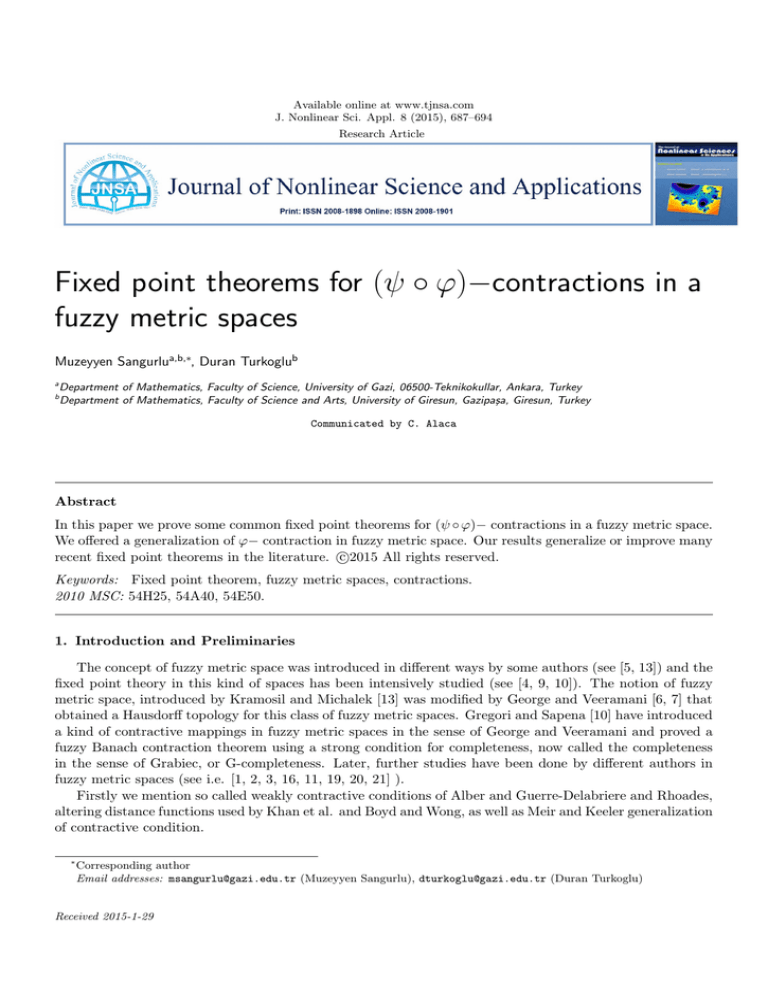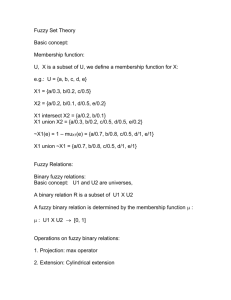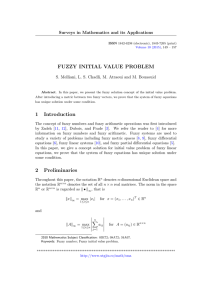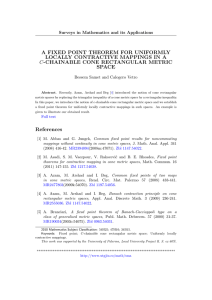
Available online at www.tjnsa.com
J. Nonlinear Sci. Appl. 8 (2015), 687–694
Research Article
Fixed point theorems for (ψ ◦ φ)−contractions in a
fuzzy metric spaces
Muzeyyen Sangurlua,b,∗, Duran Turkoglub
a
b
Department of Mathematics, Faculty of Science, University of Gazi, 06500-Teknikokullar, Ankara, Turkey
Department of Mathematics, Faculty of Science and Arts, University of Giresun, Gazipaşa, Giresun, Turkey
Communicated by C. Alaca
Abstract
In this paper we prove some common fixed point theorems for (ψ ◦ φ)− contractions in a fuzzy metric space.
We offered a generalization of φ− contraction in fuzzy metric space. Our results generalize or improve many
c
recent fixed point theorems in the literature. ⃝2015
All rights reserved.
Keywords: Fixed point theorem, fuzzy metric spaces, contractions.
2010 MSC: 54H25, 54A40, 54E50.
1. Introduction and Preliminaries
The concept of fuzzy metric space was introduced in different ways by some authors (see [5, 13]) and the
fixed point theory in this kind of spaces has been intensively studied (see [4, 9, 10]). The notion of fuzzy
metric space, introduced by Kramosil and Michalek [13] was modified by George and Veeramani [6, 7] that
obtained a Hausdorff topology for this class of fuzzy metric spaces. Gregori and Sapena [10] have introduced
a kind of contractive mappings in fuzzy metric spaces in the sense of George and Veeramani and proved a
fuzzy Banach contraction theorem using a strong condition for completeness, now called the completeness
in the sense of Grabiec, or G-completeness. Later, further studies have been done by different authors in
fuzzy metric spaces (see i.e. [1, 2, 3, 16, 11, 19, 20, 21] ).
Firstly we mention so called weakly contractive conditions of Alber and Guerre-Delabriere and Rhoades,
altering distance functions used by Khan et al. and Boyd and Wong, as well as Meir and Keeler generalization
of contractive condition.
∗
Corresponding author
Email addresses: msangurlu@gazi.edu.tr (Muzeyyen Sangurlu), dturkoglu@gazi.edu.tr (Duran Turkoglu)
Received 2015-1-29
M. Sangurlu, D. Turkoglu, J. Nonlinear Sci. Appl. 8 (2015), 687–694
688
Cyclic representations and cyclic contractions were introduced by Kirk et al. [12] and further used by
several authors to obtain various fixed point results (see [8]).
In 2010, the concept of cyclic φ− contraction is introduced by Păcurar and Rus [15]. Meantime, they
constructed a fixed point theorem for the cyclic φ− contraction in a classical complete metric space. In
addition, several problems in connection with the fixed point are investigated. Later the notion of cyclic
φ− contraction in fuzzy metric space have been proved by Y. H. Shen, D. Qıu and W. Chen [18]. H. K.
Nashine, Z. Kadelburg [14] have presented some fixed point results for mappings which satisfy cyclic weaker
(ψ ◦ φ)− contractions and cyclic weaker (ψ, φ)− contractions in 0-complete partial metric spaces.
In this paper we prove some common fixed point theorems for (ψ ◦ φ)− contractions in a fuzzy metric
space. We offered a generalization of φ− contraction in fuzzy metric space. Our results generalize or improve
many recent fixed point theorems in the literature.
We shall require the following definitions and lemmas in the sequel.
Definition 1.1 ([17]). A binary operation T : [0, 1] × [0, 1] → [0, 1] is called a continuous triangular norm
(in short, continuous t−norm) if it satisfies the following conditions:
(TN-1) T is commutative and associative,
(TN-2) T is continuous,
(TN-3) T (a, 1) = a for every a ∈ [0, 1] ,
(TN-4) T (a, b) ≤ T (c, d) whenever a ≤ c, b ≤ d and a, b, c, d ∈ [0, 1].
An arbitrary t−norm T can be extended (by associativity) in a unique way to an n ary operator taking for
(x1 , x2 , ..., xn ) ∈ [0, 1]n , n ∈ N, the value T (x1 , x2 , ..., xn ) is defined, in Ref.[7], by
n−1
n
0
xi , xn ) = T (x1 , x2 , ..., xn ).
TI=1
˙ xi = T (TI=1
˙ xi = 1, TI=1
˙
Definition 1.2 ([6]). A fuzzy metric space is an ordered triple (X, M, T ) such that X is a nonempty set,
T is a continuous t-norm and M is a fuzzy set on X 2 × (0, ∞), satisfying the following conditions, for all
x, y, z ∈ X, s, t > 0 :
(FM-1) M (x, y, t) > 0,
(FM-2) M (x, y, t) = 1 iff x = y,
(FM-3) M (x, y, t) = M (y, x, t),
(FM-4) T ( M (x, y, t), M (y, z, s)) ≤ M (x, z, t + s),
(FM-5) M (x, y, ·) : (0, ∞) → (0, 1] is continuous.
Definition 1.3 ([9]). Let (X, M, T ) be a fuzzy metric space. Then
(i) A sequence {xn } in X is said to converge to x in X, denoted by xn → x, if and only if lim M (xn , x, t) = 1
n→∞
for all t > 0, i.e. for each r ∈ (0, 1) and t > 0, there exists n0 ∈ N such that M (xn , x, t) > 1 − r for all
n ≥ n0 .
(ii) A sequence {xn } is a G-Cauchy sequence if and only if lim M (xn , xn+p , t) = 1 for any p > 0 and t > 0.
n→∞
(iii) The fuzzy metric space (X, M, T ) is called G-complete if every G-Cauchy sequence is convergent.
Definition 1.4 ([18]). Let (X, M, T ) be a fuzzy metric space and let {fn } be a sequence of self mapping
on X. f0 : X → X is a given mapping. The sequence {fn } is said to converge uniformly to f0 if for each
ϵ ∈ (0, 1) and t > 0, there exists n0 ∈ N such that
M (fn (x), f0 (x), t) > 1 − ϵ
for all n ≥ n0 and x ∈ X.
Definition 1.5 ([18]). A function ψ : [0, 1] −→ [0, 1] is called a comparison function if it satisfies
(i) ψ is left continuous and non-decreasing,
(ii) ψ(t) > t for all t ∈ (0, 1).
M. Sangurlu, D. Turkoglu, J. Nonlinear Sci. Appl. 8 (2015), 687–694
689
Lemma 1.6 ([18]). If ψ be a comparison function, then
(i) ψ(1) = 1,
(ii) lim ψ n (t) = 1 for all t ∈ (0, 1), where ψ n (t) denotes the composition of ψ(t) with itself n times.
n→+∞
In 2003 Kirk et al. introduced the following notion of cyclic representation.
Definition 1.7 ([15]). Let X be a nonempty set, m a positive integer and f : X −→ X an operator. Then
X = ∪m
i=1 Ai is a cyclic representation of X with respect to f if
(a) Ai , i = 1, .., m are non-empty subsets of X,
(b) f (A1 ) ⊂ A2 , f (A2 ) ⊂ A3, ..., f (Am−1 ) ⊂ Am , f (Am ) ⊂ A1 .
Definition 1.8 ([19]). Two mappings f and g of a fuzzy metric space (X, M, ∗) into itself are said to be
weakly commuting if
M (f gx, gf x, t) ≥ M (f x, gx, t) ∀x ∈ X.
2. Main Results
Definition 2.1. Let (X, M, T ) be a G-complete fuzzy metric space and Pcl (X) denotes the collection of
nonempty closed subsets of X. m a positive integer, A1 , A2 , ..., Am ∈ Pcl (X), Y = ∪m
i=1 Ai , and f : Y → Y
an operator. If,
(i) Y = ∪m
i=1 Ai is a cyclic represention of Y with respect to f,
(ii) There exists a function φ : [0, 1] −→ [0, 1] such that
(φ1 ) φ is non-decreasing and continuous function,
(φ2 ) φ(t) > 0 for t > 0 , φ(1) = 1 and φ(0) = 0,
(φ3 ) φ(t) ≤ t for all t ∈ (0, 1),
(iii) φ(M (f x, f y, t)) ≥ ψ(φ(M (x, y, t))) where ψ is a function as in Definition 1.5,
for any x ∈ Ai , y ∈ Ai+1 and t > 0,where Am+1 = A1 , then f is called cyclic weaker (ψ ◦ φ)− contraction
in the fuzzy metric space (X, M, T ).
Theorem 2.2. Let (X, M, T ) be a G-complete fuzzy metric space, m a positive integer, A1 , A2 , ..., Am ∈
Pcl (X), Y = ∪m
i=1 Ai , and f : Y → Y an operator. Assume that
(1) Y = ∪m
A
i=1 i is a cyclic represention of Y with respect to f,
(2) f : Y → Y is a cyclic weaker (ψ ◦ φ)− contraction.
Then f has a unique fixed point x ∈ ∩m
i=1 Ai and the iterative sequence {xn }n≥0 (xn = f (xn−1 ), n ∈ N)
converges to x for any starting point x0 ∈ Y.
Proof. Fix x0 ∈ X and define the sequence (xn ) by
x1 = f (x0 ), x2 = f (x1 ), ..., x2n+1 = f (x2n ), x2n+2 = f (x2n+1 ), ...
For any n ≥ 0, there exists in ∈ {1, 2, ..., m} such that xn ∈ Ain and xn+1 ∈ Ain+1 . Therefore, we can obtain
φ(M (xn , xn+1 , t)) = φ(M (f (xn−1 ), f (xn ), t)) ≥ ψ(φ(M (f (xn−1 ), f (xn ), t)))
Consider the definition of ψ, we get by induction that
M (xn , xn+1 , t) ≥ φ(M (xn , xn+1 , t)) ≥ ψ n (φ(M (x0 , x1 , t)) > 0.
Thus, for any p > 0,we have
t
t
t
M (xn , xn+p , t) ≥ T (M (xn , xn+1 , ), M (xn+1 , xn+2 , ), ..., M (xn+p−1 , xn+p , ))
p
p
p
t
t
t
≥ T (ψ n (φ(M (x0 , x1 , ))), ψ n+1 (φ(M (x0 , x1 , ))), ..., ψ n+p−1 (φ(M (x0 , x1 , ))))
p
p
p
t
p−1 n+i
= Tı=0 ψ (M (x0 , x1 , )).
p
M. Sangurlu, D. Turkoglu, J. Nonlinear Sci. Appl. 8 (2015), 687–694
690
By Lemma 1.6, for every i ∈ {0, 1, ..., p − 1}, we obtain that
t
lim ψ n+i (M (x0 , x1 , )) = 1.
p
n→∞
According to the continuitiy of t-norm T , it can easily be verified that M (xn , xn+p , t) → 1 as n → ∞. It
shows that {xn }n≥0 is a G-Cauchy. Since Y is G-complete, then there exists x ∈ Y such that xn → x.
On the other hand, by the condition (1), it follows that the iterative sequence {xn }n≥0 has an infinite
number of terms in each Ai , i = 1, 2, ..., m. Since Y is G-complete, from each Ai , i = 1, 2, ..., m, one can
extract a subsequence of {xn }n≥0 which converges to x as well. Because each Ai , i = 1, 2, ..., m is closed,
m
m
we conclude that x ∈ ∩m
i=1 Ai and thus ∩i=1 Ai ̸= ∅. Set Z = ∩i=1 Ai . Obviously, Z is also closed and
G-complete. Consider the restriction of f to Z, that is, f |Z : Z → Z. Next, we will prove that f |Z has a
unique fixed point in Z ⊂ Y.
For the foregoing x ∈ Z, since f |Z (x) ∈ Z and xn ∈ Ain , we can choose Ain +1 such that f |Z (x) ∈ Ain +1 .
Hence, for any t > 0, we have
M (f |Z (x), x, t) = M (f (x), x, t)
t
t
≥ T (M (f (x), f (xn ), ), M (xn+1 , x, ))
2
2
t
t
≥ T (ψ(φ(M (x, xn , )), M (xn+1 , x, )
2
2
from (TN-3) we get n → ∞, T (1, 1) = 1. Clearly, we get f |Z (x) = x, namely, x a fixed point, which is
obtained by iteration from starting point x0 . To show uniqueness, we assume that z ∈ ∩m
i=1 Ai is another
fixed point of f |Z . Since x, z ∈ Ai for all i ∈ N, we can obtain
φ(M (x, z, t)) = φ(M ((f |Z (x), f |Z (z), t)) = φ(M (f (x), f (z), t)) ≥ ψ(φ(M (x, z, t))) > φ(M (x, z, t)).
This leads to a contradiction. Thus, x is the unique fixed of f |Z for any starting point x0 ∈ Z ⊂ Y.
Now, we still have to prove that iterative sequence {xn }n≥0 converges to x for any initial point x0 ∈ Y.
m
Let y ∈ Y = ∪m
i=1 Ai , there exists i0 ∈ {0, 1, ..., m} such that y ∈ Ai0 . As x ∈ ∩i=1 Ai , it follows that x ∈ Ai0 +1
as well. Then, for any t > 0, we have
φ(M (f (y), f (x), t)) ≥ ψ(φ(M (y, x, t)).
By induction, we can obtain
φ(M (xn , x, t)) = φ(M (f n (x0 ), x, t)) = φ(M (f n (x0 ), f (x), t))
= φ(M (f (f n−1 (x0 ), f (x), t))
≥ ψ(φ(f n−1 (x0 ), x, t)
≥ ....
≥ ψ n (φ(x0 , x, t)).
Supposing x0 ̸= x, it follows immediately that xn → x as n → ∞. So the iterative sequence {xn }n≥0
converges to the unique fixed point x of f for any starting point x0 ∈ Y.
Now, for all t > 0,
φ(M (x2n+1 , f (x), t)) = φ(M (f (x2n ), f (x), t)) ≥ ψ(φ(M (x2n , x, t)))
and since f is continuous and property of φ, letting n → ∞ it follows,
M (x, f (x), t) ≥ φ(M (x, f (x), t)) ≥ ψ(1) = 1
hence f (x) = x. Then, x is a fixed point of f .
Now we prove the uniqueness of the fixed points of f . Assume that x, y ∈ X are two common fixed points
M. Sangurlu, D. Turkoglu, J. Nonlinear Sci. Appl. 8 (2015), 687–694
691
of f . If x ̸= y, then there exists t > 0 such that 0 < M (x, y, t) < 1 and hence
φ(M (x, y, t)) = φ(M (f (x), f (y), t)) ≥ ψ(φ(M (x, y, t))
= ψ(φ(M (x, y, t))) > φ(M (x, y, t)),
which is a contradiction. Therefore x = y.
√
Example 2.3. Let X be the subset of R defined by X = {1, 2, 3, 4, 5}. ψ(λ) = λ, φ(λ) = λ for all
2d(x, y)
−
t
λ ∈ [0, 1]. Define M (x, y, t) = e
, where d(x, y) = |x − y| . Clearly (X, M, T ) is a G-complete fuzzy
metric space with respect to t−norm T (a, b) = ab. Let f : X → X be given by
f (1) = f (2) = f (3) = f (4) = 2,
f (5) = 1.
Set A1 = {1, 2, 3, 4}, A2 = {2, 4, 5}. f (A1 ) = {2} ⊆ A2 , f (A2 ) = {1, 2} ⊆ A1 . According to Definition 1.7,
X = A1 ∪ A2 is a cyclic representation of X with respect to f. In addition, it can easily be verified that
φ(M (f x, f y, t)) ≥ ψ(φ(M (x, y, t))) for every x ∈ A1 , y ∈ A2 and t > 0. This shows that f a cyclic weaker
(ψ ◦ φ)− contraction. Hence all the conditions of Theorem 2.2 are satisfied and then f has a unique fixed
point, that is, x = 2.
Theorem 2.4. Let (X, M, T ) be a G-complete fuzzy metric space, m a positive integer, A1 , A2 , ..., Am ∈
Pcl (X), Y = ∪m
i=1 Ai , and f, g : Y → Y two operators. Assume that
(1) Y = ∪m
A
i=1 i is a cyclic represention of Y with respect to f and g,
(2) f and g are two cyclic weaker (ψ ◦ φ)− contractions,
(3) φ(M (f x, gy, t)) ≥ ψ(φ(min{M (x, y, t), M (f x, x, t), M (x, gx, t)})) for all x, y ∈ X and t > 0.
Then f and g have a unique common fixed point x ∈ ∩m
i=1 Ai .
Proof. Fix x0 ∈ X and define the sequence (xn ) by
x1 = f (x0 ), x2 = g(x1 ), ..., x2n+1 = f (x2n ), x2n+2 = g(x2n+1 ), ...
Similarly from the proof of Theorem 2.2, (xn ) is a G-Cauchy. Since X is G-complete, then there exists
x ∈ X such that xn → x. Now, for all t > 0,
φ(M (x2n+1 , f (x), t)) = φ(M (f (x2n ), f (x), t)) ≥ ψ(φ(M (x2n , x, t)))
and since f is continuous and property of φ, letting n → ∞ it follows,
M (x, f (x), t) ≥ φ(M (x, f (x), t)) ≥ ψ(1) = 1
hence f (x) = x. Then, x is a fixed point of f . Analogously, we obtain that g(x) = x and x is a common
fixed point of f and g.
Now we prove the uniqueness of the fixed points of f and g . Assume that x, y ∈ X are two common
fixed points of f and g. If x ̸= y, then there exists t > 0 such that 0 < M (x, y, t) < 1 and hence
φ(M (x, y, t)) = φ(M (f (x), g(y), t)) ≥ ψ(φ(min{M (x, y, t), M (f x, x, t), M (x, gx, t)})
= ψ(φ(M (x, y, t))) > φ(M (x, y, t)),
which is a contradiction. Therefore x = y.
Corollary 2.5. If we get f = g in Theorem 2.4, we obtain Theorem 2.2.
M. Sangurlu, D. Turkoglu, J. Nonlinear Sci. Appl. 8 (2015), 687–694
692
Theorem 2.6. Let (X, M, T ) be a G-complete fuzzy metric space, m a positive integer, A1 , A2 , ..., Am ∈
Pcl (X), Y = ∪m
i=1 Ai , and f and g satisfying the following conditions:
(1) f is a cyclic weaker (ψ ◦ φ)− contraction and g, s are two continuous mappings,
(2) f (X) ⊂ g(X) ∩ s(X) and (f, g), (f, s) are weakly commuting,
(3) φ(M (f x, gy, t)) ≥ ψ(φ(min{M (gx, sy, t), M (gx, f x, t), M (gx, f y, t), M (sy, f y, t)}))
for all x, y ∈ X and t > 0.
Then f , g and s have a unique common fixed point x ∈ ∩m
i=1 Ai .
Proof. Let x0 ∈ X be any arbitrary point. Since f (X) ⊂ g(X) then there exists a point x1 ∈ X such that
f x0 = gx1 . Also, since f (X) ⊂ s(X), there exists another point x2 ∈ X such that f x1 = sx2 .
In general, we get a sequence (yn ) recursively as
yn = gxn+1 = f xn and yn+1 = sxn+2 = f xn+1, n ∈ N.
Let Mn = M (yn+1 , yn , t) = M (f xn+1 , f xn , t) and M (y0 , y1 , t) > 0. Then,
Mn+1 = M (yn+2 , yn+1 , t) = M (f xn+2 , f xn+1 , t).
Using inequality (3), we get,
φ(Mn+1 ) = φ(M (f xn+2 , f xn+1 , t)) ≥ ψ(φ(min{M (gxn+2 , sxn+1 , t), M (gxn+2 , f xn+2 , t),
M (gxn+2 , f xn+1 , t), M (sxn+1 , f xn+1, t)}))
= ψ(φ(min{M (f xn+1 , f xn , t), M (f xn+1 , f xn+2 , t), M (f xn+1 , f xn+1 , t),
M (f xn , f xn+1, t)}))
= ψ(φ min{Mn , Mn+1 , 1, Mn }))
If Mn > Mn+1 , then by definition of ψ and φ we have
φ(Mn+1 ) ≥ ψ(φ(Mn+1 )) > φ(Mn+1 )
a contradiction. So,
φ(Mn+1 ) ≥ ψ(φ(Mn )).
Thus, we get,
M (yn+2 , yn+1 , t) ≥ ψ(φ(M (yn+1 , yn , t)))
∀n ∈ N, t > 0.
Hence, repeating this inequality n times we obtain,
M (yn , yn+1 , t) ≥ ψ n (φ(M (y0 , y1 , t)))
Letting n → ∞ , from Lemma 1.6 we get,
lim M (yn , yn+1 , t) = 1.
n→∞
That is, from Definition 1.3 we get that (yn ) is a G-Cauchy. Since X is G-complete, then there exists z ∈ X
such that yn → z. Hence (f xn ) → z ∈ X. Since f is a cyclic weaker (ψ ◦ φ)− contraction and by definition
of ψ and φ ,
M (yn , f z, t) ≥ φ(M (yn , f z, t)) = φ(M (f xn , f z, t)) ≥ ψ(φ(M (xn , z, t))),
By taking the limit as n → ∞ we obtain,
M (z, f z, t) ≥ ψ(1) = 1.
hence f z = z. Since (f xn ) → z ∈ X, hence the subsequences (gxn ) and (sxn ) of (f xn ) have the same limit.
Since g is continuous, in this case we have gf xn → gz, ggxn → gz. Also (f, g) is weakly commuting, we
have f gxn → gz. Let x = gxn , y = xn in (3) we get,
φ(M (f gxn , f xn , t)) ≥ ψ(φ(min{M (ggxn , sxn , t), M (ggxn , f gxn , t),
M (ggxn , f xn , t), M (sxn , f xn , t)})).
M. Sangurlu, D. Turkoglu, J. Nonlinear Sci. Appl. 8 (2015), 687–694
693
Taking limit n → ∞,
φ(M (gz, z, t)) ≥ ψ(φ(min{M (gz, z, t), M (gz, gz, t), M (gz, z, t), M (z, z, t)}))
= ψ(φ(min{M (gz, z, t), 1, M (gz, z, t), 1}))
= ψ(φ(M (gz, z, t)))
> φ(M (gz, z, t))
So, we get gz = z. Since s is continuous, in this case we have ssxn → sz, sf xn → sz. Also (f, s) is weakly
commuting, we have f sxn → sz. Now, let x = xn , y = sxn in (3) we get,
φ(M (f xn , f sxn , t)) ≥ ψ(φ(min{M (gxn , ssxn , t), M (gxn , f xn , t),
M (gxn , f sxn , t), M (ssxn , f sxn , t)}))
Taking limit n → ∞,
φ(M (z, sz, t)) ≥ ψ(φ(min{M (z, sz, t), M (z, z, t), M (z, sz, t), M (sz, sz, t)}))
= ψ(φ(min{M (z, sz, t), 1, M (z, sz, t), 1}))
= ψ(φM (sz, z, t)))
> φ(M (z, sz, t))
So, we get sz = z. Thus, we have f z = gz = sz = z. Hence z is a common fixed point of f, g and s.
Now we prove the uniqueness of the common fixed points of f , g and s. Let v be another common fixed
point of f , g and s, then f v = gv = sv = v. Put x = z, y = v in (3), we get,
φ(M (z, v, t)) ≥ ψ(φ(min{M (gz, sv, t), M (gz, f z, t), M (gz, f v, t), M (sv, f z, t)}))
= ψ(φ(M (z, v, t)))
> φ(M (z, v, t))
which gives z = v. Therefore z is a unique common fixed point of f , g and s.
If we take s = g, then we get following corollary:
Corollary 2.7. Let (X, M, T ) be a G-complete fuzzy metric space, m a positive integer, A1 , A2 , ..., Am ∈
Pcl (X), Y = ∪m
i=1 Ai , and f and g satisfying the following conditions:
(1) f is a cyclic weaker (ψ ◦ φ)− contraction and g is a continuous mapping,
(2) f (X) ⊂ g(X) and (f, g) is weakly commuting,
(3) φ(M (f x, gy, t)) ≥ ψ(φ(min{M (gx, gy, t), M (gx, f x, t), M (gx, f y, t), M (gy, f y, t)}))
for all x, y ∈ X and t > 0.
Then f and g have a unique common fixed point in Y.
In this paper, we presented the notion of cyclic weaker (ψ ◦ φ)− contraction in a fuzzy metric space
and proved a fixed point theorem for this type of mapping in a G-complete fuzzy metric space. In our
next research, we intend to establish a fixed point theorem for cyclic weaker (ψ ◦ φ)− contraction in an
M-complete fuzzy metric space.
References
[1] A. Aliouche, F. Merghadi, A. Djoudi, A related fixed point theorem in two fuzzy metric spaces, J. Nonlinear Sci.
Appl., 2 (2009), 19–24. 1
[2] I. Altun, D. Mihet, Ordered non-Archimedean fuzzy metric spaces and some fixed point results, Fixed Point Theory
Appl., 2010 (2010), 11 pages. 1
[3] M. S. Chauan, V. H. Badshah, V. S. Chouhan, Common fixed point of semi compatible maps in fuzzy metric
spaces, Kathmandu Uni. J. Sci. Engin. Tech., 6 (2010 ), 70–78. 1
[4] C. Di Bari, C. Vetro, Fixed points, attractors and weak fuzzy contractive mappings in a fuzzy metric space, J.
Fuzzy Math., 13 (2005), 973–982. 1
[5] Z. Deng, Fuzzy pseudometric spaces, J. Math. Anal. Appl., 86 (1982), 74–95. 1
M. Sangurlu, D. Turkoglu, J. Nonlinear Sci. Appl. 8 (2015), 687–694
694
[6] A. George, P. Veeramani, On some results in fuzzy metric spaces, Fuzzy Sets and Systems, 64 (1994), 395–399.
1, 1.2
[7] A. George, P. Veeramani, On some results of analysis for fuzzy metric spaces, Fuzzy Sets and Systems, 90 (1997),
365–368. 1, 1.1
[8] D. Gopal, M. Imdad, C. Vetro, M. Hasan, Fixed point theory for cyclic weak ϕ−contraction in fuzzy metric spaces,
J. Nonlinear Anal. Appl., 2012 (2012), 11 Pages. 1
[9] M. Grabiec, Fixed points in fuzzy metric spaces, Fuzzy Sets and Systems, 27 (1988), 385–389. 1, 1.3
[10] V. Gregori, A. Sapena, On fixed-point theorems in fuzzy metric spaces, Fuzzy Sets and Systems, 125 (2002),
245–252. 1
[11] S. Jain, S. Jain, L. B. Jain, Compatibility of type (P) in modified intuitionistic fuzzy metric space, J. Nonlinear
Sci. Appl., 3 (2010), 96–109 . 1
[12] W. A. Kirk, P. S. Srinavasan, P. Veeramani, Fixed points for mapping satisfying cyclical contractive conditions,
Fixed Point Theoery, 4 (2003), 79–89. 1
[13] I. Kramosil, J. Michalek, Fuzzy metric and statistical metric spaces, Kybernetica, 11 (1975), 336–344. 1
[14] H. K. Nashine, Z. Kadelburg, Fixed point theorems using cyclic weaker meir-keeler functions in partial metric
spaces, Filomat, 28 (2014), 73–83. 1
[15] M. Păcurar, I. A. Rus, Fixed point theory for cyclic ϕ−contractions, Nonlinear Anal., 72 (2010), 1181–1187. 1,
1.7
[16] K. P. R. Rao, A. Aliouche, G. R. Babu, Related fixed point theorems in fuzzy metric spaces, J. Nonlinear Sci.
Appl., 1 (2008), 194–202. 1
[17] B. Schweizer, A. Sklar, Statistical metric spaces, Pacific J. Math., 10 (1960), 313–334. 1.1
[18] Y. H. Shen, D. Qiu, W. Chen, Fixed point theory for cyclic ϕ−contractions in fuzzy metric spaces, Iran. J. Fuzzy
Syst., 10 (2013), 125–133. 1, 1.4, 1.5, 1.6
[19] D. Turkoglu, M. Sangurlu, Fixed point theorems for fuzzy ψ−contractive mappings in fuzzy metric spaces, J.
Intell. Fuzzy Syst., 26 (2014), 137–142. 1, 1.8
[20] R. Vasuki, P. Veeramani, Fixed point theorems and Cauchy sequences in fuzzy metric spaces, Fuzzy Sets and
Systems, 135 (2003), 415–417. 1
[21] C. Vetro, Fixed points in a weak non-Archemedean fuzzy metric spaces, Fuzzy Sets and Systems, 162 (2011),
84–90. 1




